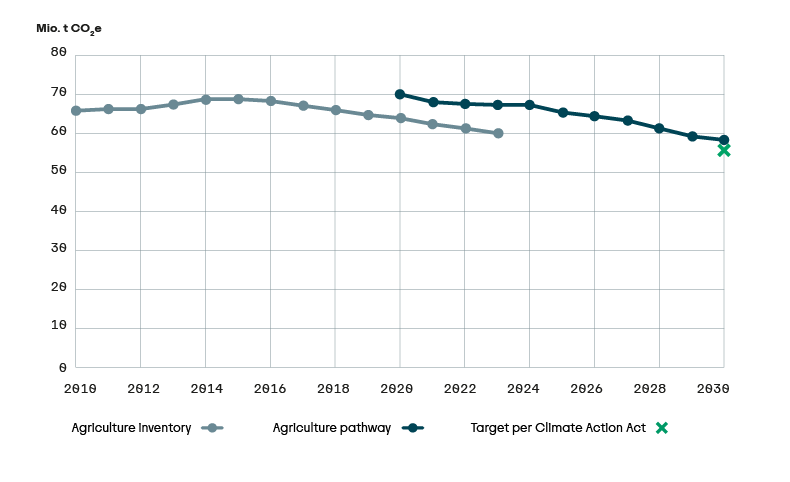Agriculture sector targets in
the German government’s climate strategy
The German government’s stated goal is to reconcile the core tasks of agriculture – food security, climate change mitigation, supplies of renewable raw materials, and the preservation of natural resources – with the transformation of the agriculture sector with as little conflict as possible. The focal point through the year 2045 is emission reduction and resource efficiency in sustainable agricultural production.
The German Federal Climate Action Act (Bundes-Klimaschutzgesetz, KSG) enacted by the German government in 2019 and amended in 2021 specifies that agricultural emissions (including emissions from agricultural fuel combustion, both mobile and stationary) must be reduced to 56 million tons of CO2 equivalents by the year 2023. Based on the target undershoots of emission quantities in the last few years and the pro-rated reallocation, the permissible emission quantity has been raised to 58.4 million tons of CO2e (see Figure 4).
The primary emission reduction measures named by the German government are the lowering of nitrogen surpluses and the reduction of fossil fuel use, to be accomplished through a transformation to a bio-based economy. Based on these two primary actions and other accompanying actions, the German government’s climate strategy aims to reduce GHG emissions in agriculture by the year 20301. A further, significant reduction of emissions by the year 2050 is supposed to be achieved by various measures, including the targeted promotion of or increased land area devoted to organic farming.
The emission reduction requirement presents challenges for agriculture and for Landwirtschaftliche Rentenbank. However, it also presents an opportunity to make a positive contribution to climate change mitigation with innovative solutions and sustainable financing practices. The challenge of meeting the national and international climate targets demands a resolute and coordinated approach in which Landwirtschaftliche Rentenbank will play a key role.
Development and target attainment2 of greenhouse gas emissions of the agriculture sector (in contradistinction to the German Federal Climate Action Act3)

Figure 4: Development of emissions in comparison with the targets of the German Federal Climate Action Act, source: German Federal Environment Agency (UBA): Press Release 11/2024 dated 15/03/2024 – Climate emissions fall by 10.1 percent in 2023 – Biggest decline since 1990, UBA Projection: National climate target is achievable by 2023.